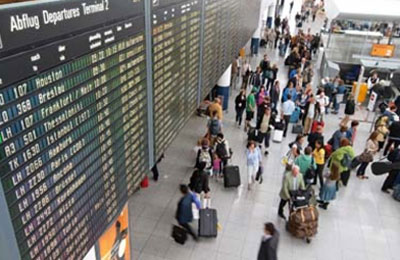
Global air passenger traffic soars 5.1pc
Geneva, September 3, 2013
International air passenger traffic recorded another solid month in July with a 5.1 per cent growth compared to the same period a year ago led by the strong growth from Middle Eastern airlines, according to according to the International Air Transport Association (IATA).
The Middle Eastern carriers experienced the highest growth rate for any region, with July traffic up 7.8 per cent compared to a year ago, said the global aviation body in its monthly report.
"While this is a fall-off from even higher year-over-year growth in June (12.1 per cent), part of the decline can be attributed to the timing of Ramadan, which has a dampening effect on demand. In 2013 Ramadan spanned most of July whereas in 2012, it occurred mostly in August. Capacity growth of 10.5 per cent sent load factors down two percentage points to 78.3 per cent, the IATA report said.
On the aviation growth, IATA said the overall revenue passenger kilometers (RPKs) surged 5 per cent compared to last year. The capacity rose slightly faster at 5.4 per cent, causing load factor to slip 0.2 percentage points to 82.7 per cent. Performance across all regions was positive.
All regions were up year-on-year, with emerging markets recording the strongest increases, said the report. The capacity rose 5.5 per cent on the previous July, ahead of demand, and industry load factor dropped 0.4 percentage points to 82.4 per cent, it added.
Although July’s 5 per cent performance was not as strong as June’s (6.1 per cent), this likely reflects both a market correction in line with prevailing economic conditions as well as the impact of reduced travel in markets observing the Ramadan period, said the report.
Commenting on the results, Tony Tyler, the director general and chief executive of IATA, said: "Passenger demand continues to be strong. But the story of emerging markets driving growth as developed economies stagnate could be shifting. We are still expecting growth of 5 per cent this year. How that growth is achieved, however, appears to be at a turning point."
Tyler pointed out that the emergence of the Eurozone from an 18-month recession provided the biggest boost to traffic over recent months.
"In contrast, the deceleration of the Chinese economy has been a dampener on air travel, with weakness showing up throughout emerging Asian markets. The price of oil, a huge cost item for airlines, is tracking political tensions in the Middle East. Along with the global cost impact of this, at the regional level there is the potential for disruption for one of aviation’s strongest and most consistent growth markets," he added.
European carriers recorded a 3.7 per cent increase in demand compared to July 2012, in line with year-to-date growth although a significant decline compared to June results (5.3 per cent).
"The Eurozone emerged from its 18-month recession during the second quarter, giving grounds for cautious optimism for the region’s performance in the second half tempered by significant variations by country. Capacity rose 3.6 per cent and load factor improved marginally to 85.5 per cent, said the IATA report.
Asia-Pacific carriers’ July traffic was up 6.3 per cent on a year ago. Capacity rose 6.6 per cent and load factor dipped 0.2 points to 79.5 per cent. The support for growth at this rate is weakening. The region’s largest economy—China—continued to decelerate in the second quarter.
"With trade volumes in emerging Asian markets shrinking by almost 5 per cent over the first half of the year, the softness is not isolated to China. In particular, India’s near term growth prospects are looking bleak. For the year we would expect performance to even-out around the 4.1 per cent growth achieved year-to-date," said the report.
North American airlines’ international traffic rose 3.6 per cent in July versus the same month last year, while capacity climbed 2.9 per cent, pushing load factor up 0.6 percentage points to 87.4 per cent, highest for any region.
Latest indicators show July business confidence reaching levels not seen since March, with consumer confidence also showing improvement at the end of the second quarter, it stated.
Latin American airlines posted year-on-year demand growth of 7.3 per cent almost perfectly aligned with capacity growth of 7.4 per cent, while the African airlines’ traffic climbed 7.5 per cent compared to July 2012, second best among the regions, said the report.
With the exception of Brazil all domestic markets experienced demand growth in July, but rates among countries varied significantly. Total traffic climbed 4.8 per cent but this was exceeded by a 5.8 per cent rise in capacity and load factor slipped to 82 per cent, it added.
"Economic growth and connectivity go hand in hand. Indeed, connectivity creates jobs and supports growth. So it is for good reason that the long-term sustainability of aviation will be high on the agenda when governments meet in Montreal at the end of this month for the 38th Assembly of the International Civil Aviation Organization (ICAO)," said Tyler.
"The aviation industry is committed to addressing its climate change impact including the challenging target of carbon-neutral growth from 2020. Governments set the same goal when they last met. So this Assembly is a golden opportunity to reach a global consensus by governments on how to achieve this goal efficiently," he added.-TradeArabia News Service







